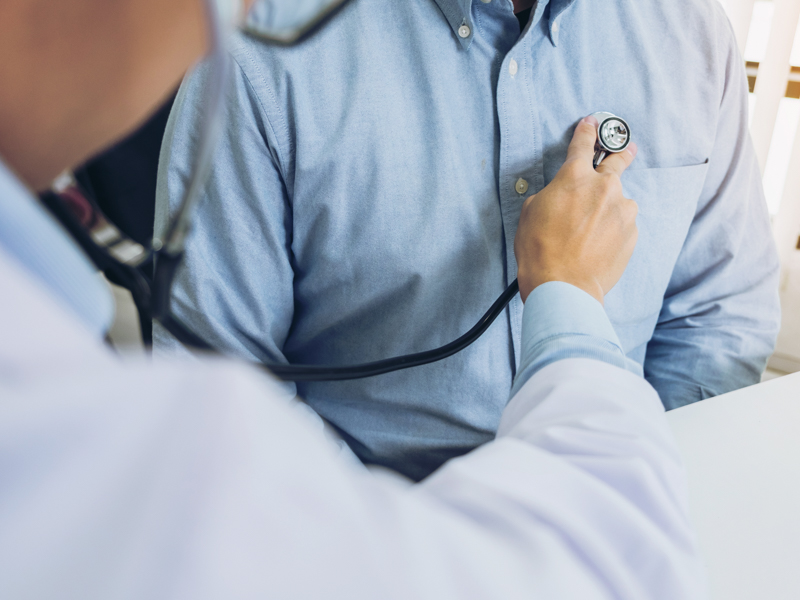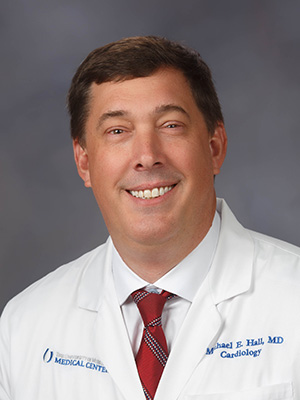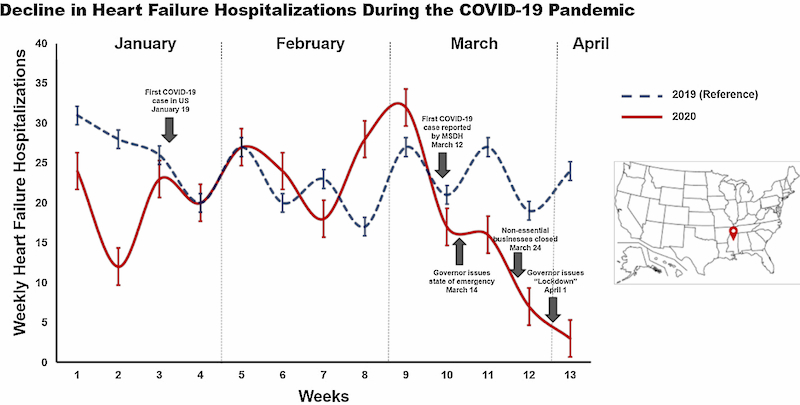Heart failure admissions plummet – is the pandemic to blame?

Of all the conditions needing prompt medical attention, among the most fatal is heart failure.
Yet, after the COVID-19 crisis commenced, the number of heart failure hospitalizations at the University of Mississippi Medical Center plunged, says a Journal of Cardiac Failure report authored by eight UMMC physicians and two others.
The physicians believe they have pegged the culprit, one they say could be confirmed in a forthcoming follow-up report: People are more afraid of catching the bewildering virus – in a hospital – than they are of dealing with a disease they know at home.
But the conceivable consequences of delaying or forswearing treatment for a disorder that deprives the brain, liver, kidneys and other organs of adequate blood flow are grim. Think heart attack, for instance, a leading cause of heart failure.

“About 50 percent of patients diagnosed with heart failure die within five years,” said Dr. Michael Hall, associate professor of medicine in the Division of Cardiovascular Diseases at UMMC, and the lead author of “Reductions in Heart Failure Hospitalizations During the COVID-19 Pandemic,” published May 12.
“It is one of the major causes of hospitalizations in the U.S. and worldwide, and as more and more people get older, it’s getting worse.”
However, after the first case of COVID-19 was diagnosed in Mississippi, those hospitalizations at the Medical Center dropped by 50 percent– from an average of 30 per week to 15.
It didn’t stop there. Heart failure admissions fell again after Mississippi declared a state of emergency, and again after the “shelter in place” order.
“The rate dropped down by more than 80 percent at one point,” Hall said late last week.
Often people are hospitalized after they show up in the emergency room with such symptoms as shortness of breath and congestion from too much fluid because of a weakened heart, signs of heart failure.

“When heart failure starts getting worse, it may not be as reversible if we don’t treat it in a timely manner,” said Dr. Javed Butler, professor and chair of the Department of Medicine, and the Patrick H. Lehan Chair of Cardiovascular Medicine at UMMC.
“I’m really worried about this from the patient’s perspective and if there are delays in seeking medical care,” said Butler, one of the article’s co-authors.
Other than dread of hospital infection, there are other possible explanations for these dwindling admissions. But they do not stand up, the physicians said.
“Reductions in many hospitalizations were intentional,” Hall said. “Those were elective cases. But heart failure is rarely an elective reason for hospitalization. You wouldn’t expect to see a decline for a disease that has a high death rate.
“We noticed also that other hospitals in the country reported a reduction in heart attack cases. You would not expect this either. The question is: Are people not coming in when they need to, and if not, why?”
Another intriguing question, Hall said: “Are patients doing better because they’re staying at home – eating out less or not at all, eating healthier, with less salt intake, and becoming less sedentary? But I think this is unlikely.”
So does Butler. “If there was a 10 percent reduction in heart failure hospitalizations because people are getting more exercise or not eating bad stuff, that’s possible,” he said.
“But when you are talking about a 50 or 60 percent reduction, no way. Even if you take care of yourself, this kind of reduction doesn’t fit with the natural history of the disease. Even when patients do everything we ask them to do, the disease still runs its course.”
Another question: Are heart failure patients getting the care they need through telehealth instead?
“We have a really robust system,” Hall said, referring to the UMMC Center for Telehealth. “It’s playing a major role in caring for these patients.
“But heart failure is one of the major health care costs in the nation. It needs very close follow-up. So it’s hard to believe that, even under the best of circumstances, a telehealth visit is going to be better for a heart failure patient that an in-person visit, and that telehealth care is the primary reason for the reduction in hospitalizations.”
In fact, Butler said, “overall care for these patients with telehealth, at best, has remained the same, but likely is less than usual.”

Apparently then, one prime suspect is left standing: Anxiety about coming to any hospital, Hall said. “People will tough it out at home or self-treat or take extra pills to reduce fluid.
“Some may not want to come to large hospitals like this one because they know we are taking care of the sickest patients. So, it’s possible that when they finally decide to come back, they will be in worse shape.”
For his part, Butler is also a co-author of another, similar report with, among others, his colleague, Dr. Muthiah Vaduganathan, a cardiologist at Brigham and Women’s Hospital in Boston, and a co-author as well of the Journal of Cardiac Failure study.
Published today in the Journal of the American College of Cardiology, “Declines in Hospitalizations for Acute Cardiovascular Conditions During the COVID-19 Pandemic: A Multicenter Tertiary Care Experience” examines those admissions at Brigham and Women’s, the teaching affiliate for Harvard Medical School.
For that matter, Butler and Hall plan to be part follow-up studies at UMMC. One will see if the hospitalization trend continues as more pandemic restrictions are loosened. Another would question patients to determine if their personal habits account for the fall-off: Are they eating less salt? Are they getting more exercise?
“But we think it’s because of the fear,” Hall said.
The thing is: “Hospitals are well-prepared to protect people against the COVID infection,” Butler said. “So, and I don’t say this lightly, going to the hospital may be safer than going to the grocery store.”
As they are in other hospitals, strict measures, such as hand hygiene, frequent cleaning and sanitization of common-use areas and screening, are in place at UMMC to ensure safety for patients, visitors and providers
“This is not to say that people should take the pandemic lightly,” Butler said. “They should take seriously the four guidelines for staying safe: social distancing, hand hygiene, wearing a mask as recommended, avoiding gatherings.
“What I believe, though, is that people who come to the Medical Center will see how aware we are of their safety, and will be satisfied.”
Don’t delay care, cardiologists urge
Across the country, clinicians have been seeing fewer patients for heart attack and stroke since the pandemic began, a trend that could be fatal for many.
In response, the American College of Cardiology is urging these patients to seek timely care, which could save their lives and reduce the risk for complications.
The ACC’s CardioSmart Website provides resources for these patients, along with an infographic listing heart attack and stroke symptoms, such as chest discomfort and shortness of breath (heart attack), and face drooping and arm weakness (stroke).
The presence of any of these symptoms, even if they go away, means it’s time to call 9-1-1.


